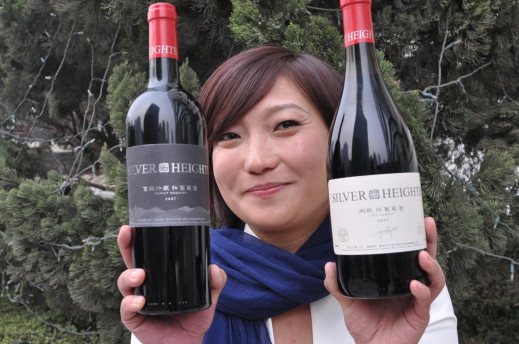Emma Gao is the chief winemaker of Silver Heights in Ningxia of China. The winery, which specializes in Cabernet Sauvignon and Cabernet Gernischt (local Carmenere), produces approximately 30,000 bottles or 2500 cases per year. Since her debut vintage in 2007, Gao has quickly gained attention from wine critics around the world.
Renowned wine writer, Jancis Robinson, once referred to her as the most naturally vivacious wine producer she has ever met. Her contributions for introducing the potentials of Ningxia and building a reputation for this region in China has made her one of the most prominent Chinese winemakers now.
Asian Palate appreciates her time out of a busy schedule to talk to us about her career, her wines and the future of China in wine.
AP: Asian Palate EG: Emma Gao
AP: How did you get your start in the profession of wine making? Was it difficult? Please share your experience.
EG: I am lucky to have a good father who chose this career for me 15 years ago. He has been supporting me to make good wines in Ningxia, which is also his dream. Torres China Wine Company, a family-owned business that has been around for approximately 600 years, discovered us because they believe only the collaboration of families can produce good wines. Therefore, they help us with the distribution and marketing, and my team along with my father can just focus what we really have a passion for, which is winemaking.
AP: How has your career been so far?
EG: We started with 10 barrels for our first vintage in 2007, and now we have expanded and improved both the quality and quantity with 1000mu (66.67 hectares) new vineyards planted.
We have also been gaining attention from the international media, such as The New York Times, reporting Ningxia as one of the 46 places most worthy to visit for tourism and wine.
AP: What’s your philosophy in wine making?
EG: Respect the environment; the sun, water and land provide us the grapes that we transfer into wine as naturally as possible, and we aim to offer every glass of our wines to consumers for their pleasure and health.
AP: Where in China do you think has the best terroir for making Cabernet-based wine?
EG: There may be many places in China but Ningxia is one of the most beneficial areas, as it is located at high altitude, 3200 hours of annual sunshine and big differences in temperatures between day and night – all these optimizes phenolic maturity.
In the whole area of northwestern China, it is necessary to cover vines underground due to the very cold winter. This causes a short lifecycle for the vines trees, as in 30 days less than Europe.
In Ningxia, the Helan Mountains serves as a natural protection for cold wind coming from Mongolia and Siberia, which provide us 15-20 days more to harvest grapes. Also, the mountains on its own is interesting in terms of minerality, and the pedal soil helps growing good quality vines.
AP: Can you please describe the state the Chinese wine market is in now?
EG: Comparing now with 5 years ago, the wine consumers are more sophisticated as they can now better determine the difference between good and poor quality of wines. However, I noticed that they have yet to understand the importance of serving wines at the right temperature.
Thanks to Torres and other importers who invest a lot of resources to educate Chinese wine consumers – we see an increase of wine consumption in China, but I believe this is just the beginning. Why I say that is because I believe in one of the Chinese medical myths which says: wine is good for health, a glass per day is better than any medications!
AP: What do you hope to achieve with Silver Heights? Please tell us about your future plans. Any chances of working with different varieties such as Pinot Noir or Shiraz?
EG: Silver Heights’ main goal has always been to build wine culture in China: spending leisure time with good friends, good food, and good wine. On the winemaking side, as our vineyards are getting on track and we are modernizing our production facilities, we hope that Silver Heights wines will reflect more of the minerality of our soils and the sharp sunshine of our terroir. Inspired by my time training in Bordeaux, we aim to continue using both Cabernet Sauvignon and the local version of Carmenere as our main grapes. Our climate here is too warm for lighter reds such as Pinot Noir, but some other varieties might be considered such as Syrah.
AP: What’s your advice for the future winemakers of China?
EG: Work hard, follow your dreams and control your own products.










